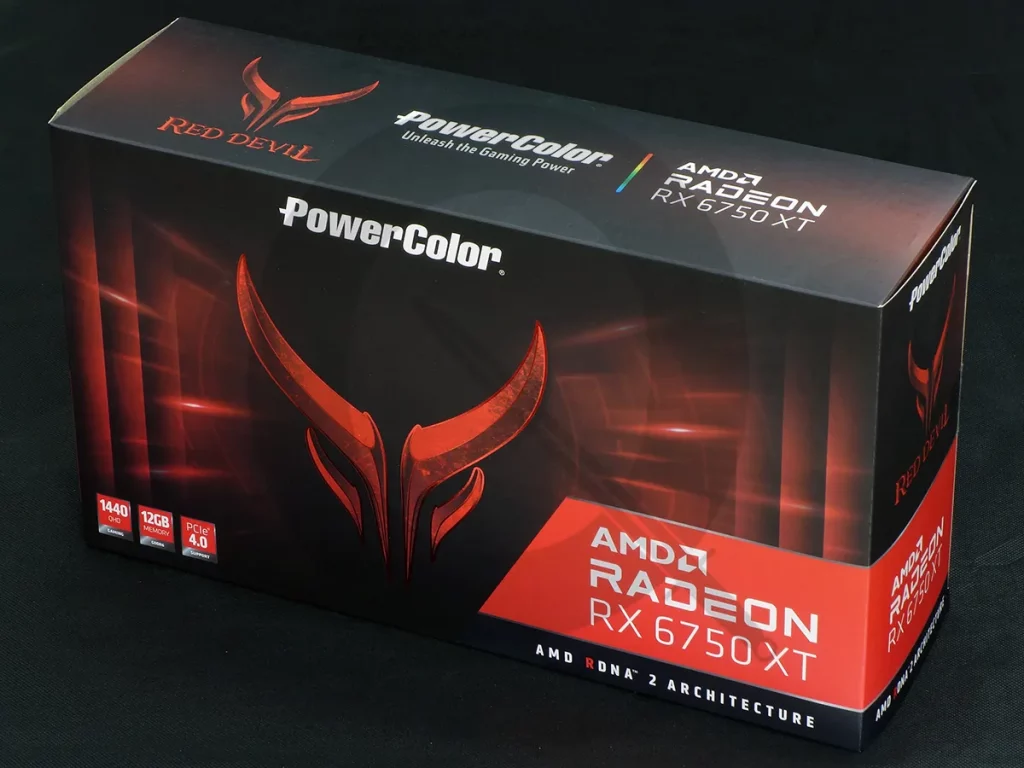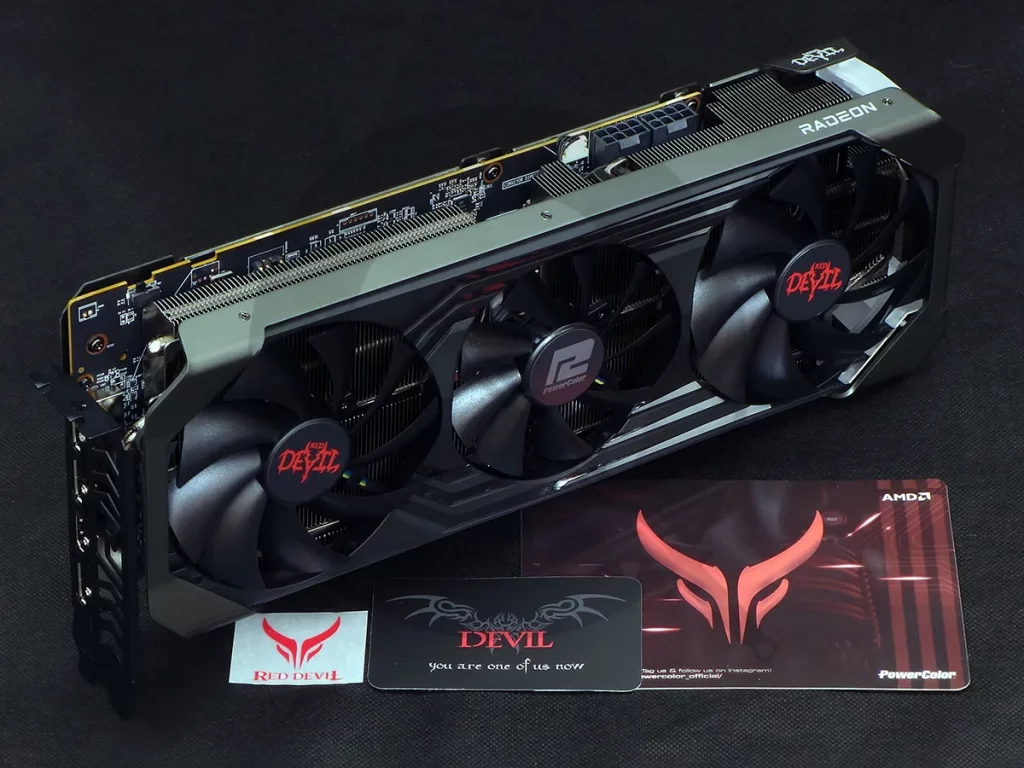Ryzen 7 7700X, 7600X, X670E & AM5: The Zen 4 Review
Will AMD repeat its former Athlon glory in its 4th generation Zen architecture? Less than half of the product’s potential market is even old enough to remember when AMD was on top, but perhaps a good swift Y2K-era kick in the rear is what its competitor needs to get moving again.

We procured examples of the bottom two models from the new series: The 7950X has two of the dice from our Ryzen 7 7700X sample, and the 7900X has two of the dice of our 7600X sample. We’re not certain which position AMD leaves empty on the single CCD (Core Complex Die) models, only that one is empty. We’ll wait for someone else de-lid (ie, remove the heat spreader from) their own 7700X or 7600X to find out.

Having noted that, these heat spreaders might be fairly thick: In order to maintain compatibility with existing CPU coolers, AMD has somehow produced an LGA -style mounting system with the same package height as its previous AM4 socket.

Noted hardware and production improvements include a 5nm production process for the CCDs and updated RDNA2 graphics engine for the I/O die. L2 cache is expanded from 8x512k to 8x1m. AMD adds AVX-512 extensions at a time when Intel is removing it from desktop models, which could set up an interesting performance dichotomy for those who still use AVX-enhanced encoder apps.

While CPU marketing numbers such as a 15% gain in IPC (Instructions Per clock Cycle) compared to AMD’s 5000-series Ryzen and 47% more work per watt than the Core i9-12900K sound alluring, platform updates will prove far more significant as the firm moves forward: We’re talking about PCI Express 5.0 and DDR5, the former providing CPU-direct bandwidth to an x16 graphics card and two NVMe x4 SSDs and the later supporting at least DDR5-6000 at native memory controller frequency.

We expect that many of the gains mentioned by AMD for its revised CPU will actually trace to its new DDR5 interface, since the firm provided DDR5-6000 C30 support kits to every launch-day review partner. Ours came from G.Skill as part number F5-6000J3038F16GX2-TZ5N Trident Z5 Neo (2x16GB non-RGB). While this specific memory supports AMD’s new EXPO integrated overclocking profiles to the exclusion of Intel XMP, some forthcoming kits are expected to include both types of SPD extension.

As part of the AM5 launch, AMD also outlined the B650 chipset that’s coming October 10 with half as many chipset-based USB and PCIe 3.0 interfaces reportedly running on half the silicon (note the dual chipset components on the X670 block diagram), all while calling out both the X670 and B660 with separate “E” models (X670E and B660E). The firm explains that while there aren’t any actual X670E or B660E chipsets, the “E” designates a higher level of
Configuring The Test Systems
ASRock’s X670E Taichi takes on its own Z690 Taichi from last November, a board that the firm developed so well that we needed only set its primary timings and voltage levels to rated values to run G.Skill’s DDR5-6000 EXPO-only memory at its rated setting on the non-EXPO board. Yet with its spanking-new X670 chipset and AM5 socket, the EXPO-enabled model still looks more current.
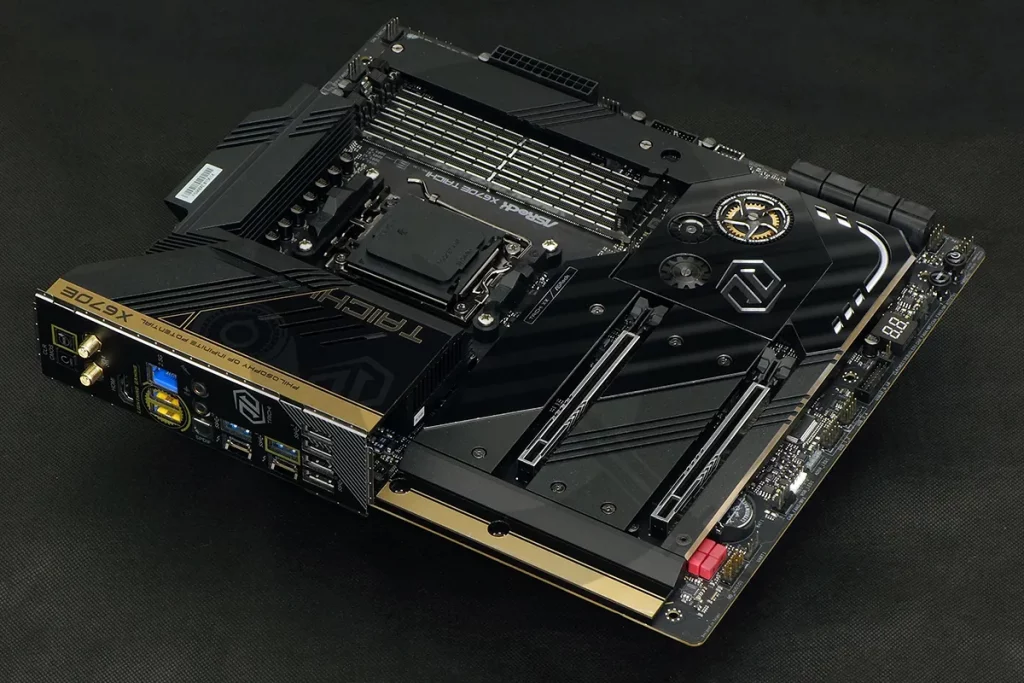
Lacking any of the newly-announced PCIe 5.0 based SSDs, we leaned back on Sabrent’s amazingly fast Rocket 4 Plus 2TB. We also decided to forgo any motherboard-included SSD heat spreaders in favor of Sabrent’s own M.2 2280 SSD Rocket Heatsink.


This is our initial test configuration.
| Test Hardware | |
| CPUs | AMD Ryzen 7 7700X: 8C/16T, 4.5-5.4 GHz, 40MB L3 Cache, Socket AM5 AMD Ryzen 5 7600X: 6C/12T, 4.7-5.3 GHz, 38MB L3 Cache, Socket AM5 Intel Core i9-12900KF: 16C/24T, 3.2-5.2 GHz, 30 MB L3 Cache, LGA 1700 |
| CPU Cooler | Alphacool Eisblock XPX CPU, Eisbecher D5 150mm, NexXxoS UT60 X-Flow 240mm |
| Graphics | Gigabyte GeForce RTX 2070 Gaming OC 8G: 1410-1725 MHz GPU, GDDR6 |
| Comparison RAM | G.Skill F5-6000J3038F16GX2-TZ5N 2x16GB (32GB) DDR5-6000 CL30-38-38-96 1.35V |
| Power | be quiet! Dark Power Pro 10 850W: ATX12V v2.3, EPS12V, 80 PLUS Platinum |
| Hard Drive | Sabrent Rocket 4 Plus 2TB PCIe 4.0 M.2 SSD |
| Sound | Integrated HD Audio |
| Network | Integrated Wi-Fi |
| Integrated Graphics Driver | AMD Adrenalin Edition 2208171015-22.20-220816a-382498E-ATI |
| Nvidia Graphics Driver | GeForce 516.94 (2022/08/09) |
After updating a couple of its applications, we threw our standard motherboard test suite at all three configurations to determine performance, efficiency, and value supremacy.
| Synthetic Benchmarks and Settings | ||
| PCMark 10 | Essentials, Productivity, Digital Content Creation | |
| 3DMark Professional Edition | Timespy, Firestrike Extreme Default Presets | |
| SiSoftware Sandra | Version 2021.12.31.104 Memory Bandwidth, Memory Latency |
|
| Cinebench R23.2 | Build RBENCHMARK330542 CPU Multi Core Benchmark |
|
| AIDA64 | Version 6.75.6100, 07/18/2022 | |
| Application Tests and Settings | ||
| LAME MP3 | Version 3.98.3 Mixed 271MB WAV to mp3: Command: -b 160 –nores (160 Kb/s) |
|
| HandBrake CLI | Version: 0.10.5-x86_64 Sintel Open Movie Project: 4.19 GB 4k mkv to x265 mp4 |
|
| Blender | Version 2.93.5 BMW 27 CPU Render Benchmark, BMW 27 GPU Render Benchmark |
|
| 7-Zip | Version 21.04 Beta integrated benchmark + custom workload bench: 7.6 GB mixed files to .7z, CL switches “a -t7z -r -m0=LZMA2 -mx=9” |
|
| Prime95 | Version 30.7 Torture Test, Small FFTs | |
| Games | ||
| F1 2021 | Settings as shown in charts | |
We typically begin motherboard tests with memory, and that seems particularly apropos when faced with AMD’s newfound DDR5 support. This is where AMD’s choice of memory is the real star, as G.Skill’s DDR5-6000 C30 provided the highest bandwidth we’ve ever seen!




The first problem is that that superb bandwidth was available only through our Intel Core i9-12900KF’s memory controller. What finally occurred to us at 7:45AM the day before launch is that AMD probably intended for everyone to test the Intel platform at DDR5 defaults, which would have generated only 57GB/s or so of bandwidth, compared to AMD’s 56GB/s or thereabout. Pairing a 12900KF with DDR5-4800 C40 might seem ludicrous to performance freaks, but in AMD’s defense it is the only standard that Intel officially supports.




We added storage to 3DMark since the new platform has PCIe 5.0, but we unfortunately didn’t have a PCIe 5.0 SSD to try yet. Overall scores end up just a tick behind the expensive 12900KF, and we just laid the baseline by which to measure future NVMe 5.0 improvements.




The Ryzen 7 7700X takes wins across PCMark 10 Essentials and Productivity as well as the photo and video editing portions of its digital content creation suite. The 7600X loses that advantage in four of the twelve tests, but still comes in second place overall.


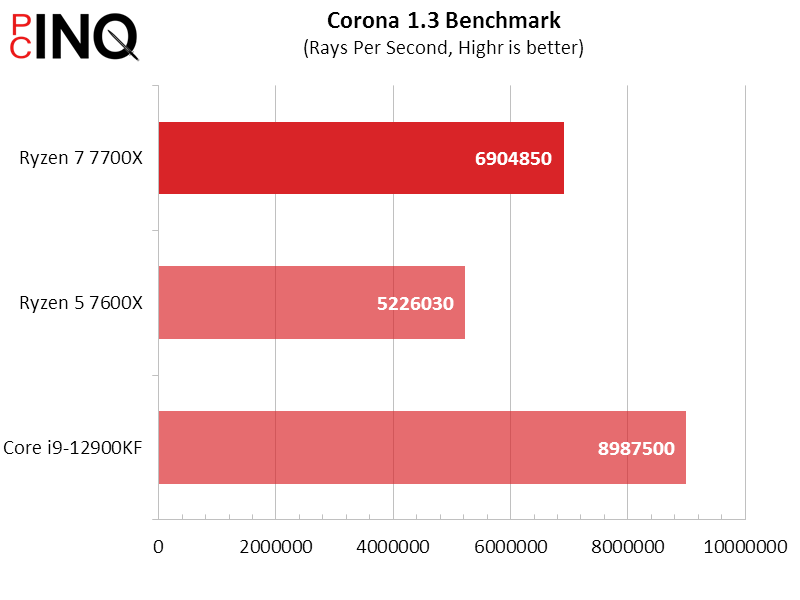
7-Zip loves DDR5 but also benefits from added cores. In this case, the Core i9-12900KF’s extra “efficiency” cores—though weak—are probably strong enough to account for the more expensive processor’s higher MIPS.

Lower is better for timed test, and 7-Zip reappears using a folder containing around 7.6GB of mixed files. AMD appears a bit stronger in that test and takes an outright win in Lame MP3 encoding.

The EGO game engine that powers F1 2021 has always been memory-bound on systems that didn’t have other noteworthy bottlenecks, yet the graphics card of this test system is old enough that it might have been a bottleneck that prevented us from seeing AMD’s claimed 11% performance advantage over the 12900. Or maybe it’s that we’re using a KF-variation of the 12900? We began looking for answers, first by adding 720p to the above chart, and then looking for exceptions.
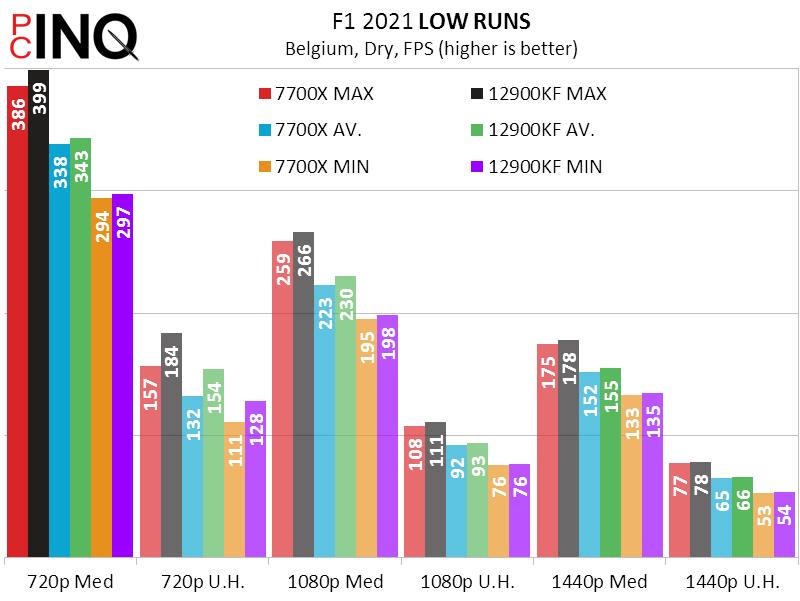
Hoping to increase performance deltas by forcing the cards to render a greater number of distant objects, our switch to “dry” weather for this test appears to have imparted an occasional (but infrequent) bad run on both the AM5 and 12900KF that we’re beginning to think might have something to do with cloud rendering. Since low runs were infrequent we recorded these as exceptions. We first thought that perhaps AMD was comparing a bad Intel run to a good AMD run, but our friends at AMD still suggested that the graphics card was the problem. That’s when a friend of a friend in the industry showed up with a card that would solve our issues:
| AMD Graphics Card | Powercolor Red Devil Radeon 6750 XT: 2324-2623MHz GPU, 12GB GDDR6 |
| AMD Graphics Driver | AMD Adrenalin Edition 2022.0915.1840.1936 |
With its powerful Navi 22 core and 12GB of GDDR6 memory, this new model should provide roughly 50% higher framerates than our elder RTX 2070.

AMD finally wins, but only at 720p. The 7700X also beats the 12900KF at 1440p, but the 7600X falls slightly behind. We spent five days looking for AMD’s quoted 11% win and came up empty. Even retesting the 12900KF at SPD defaults only dropped our score by 3.5% at most.

AMD appears to cap its power use by default, while Intel leaves it wide open. That’s going to make a big difference in our efficiency chart.
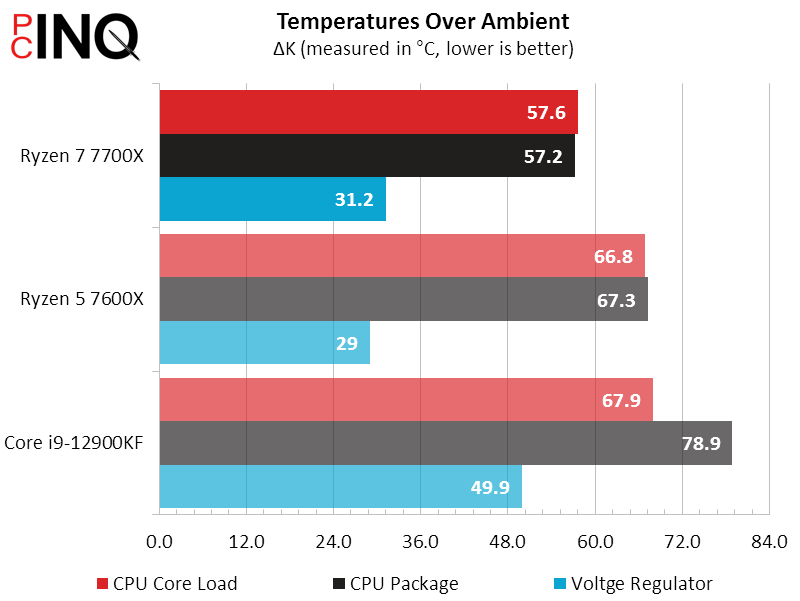
Finding the thermal results almost unbelievable, we scanned the entire board with an IR meter and felt the board around the CPU socket and voltage regulators just to see if there were any hot spots that we might have missed, and didn’t find any. The X670E Taichi runs cooler than its Intel-oriented sibling, and some of that is likely due to AMD’s CPUs drawing far less energy.

Generating an overall performance number to determine efficiency, we were happy to see the middle-model 7700X leading the high-priced 12900KF by 1.6% on-average.

With its high idle draw, these AMD models may not be 37 to 49 percent more efficient than the 12900KF in most scenarios, but would be in any situation where the load cycled between 0% and 100% equally. Moreover, that 50/50 split gets us to (and slightly past) AMD’s 47% greater work-per-watt claim.
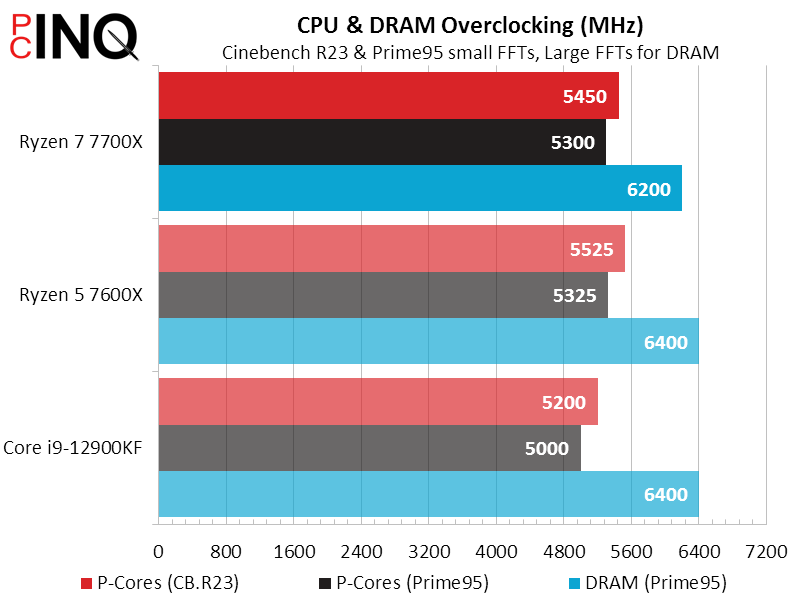
Overclocking can be a measure of motherboard stability as much as CPU capability, but as seen in the difference between 7700X and 7600X memory overclocking, the CPU still has a role.
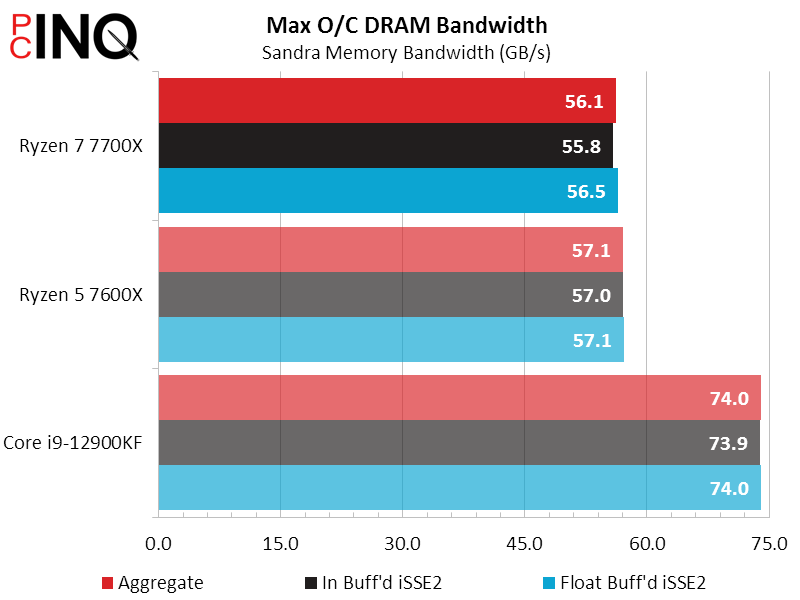
Those memory overclocks were achieved using nothing more than a primary timing adjustment from 30-38-38 to 36-42-42 for added stability. The looser timings reduced Intel’s bandwidth gain to a mere 0.2GB/s, where AMD rose by 0.4 to 0.5GB/s despite having its memory controller ratio (UCLK) drop from synchronous to ½ memory frequency at settings beyond DDR5-6000.

At $400, the Ryzen 7 7700X offers a stunning value achievement that’s matched only by its ~49% efficiency advantage when comparing the similarly-performing Core i9-12900KF. We were considering giving the Ryzen 7 7700X our highest award, but decided instead to reserve that for AMD’s best processor…if it meets the high expectations set fourth by this lower model.

Meanwhile, the Ryzen 5 offers even more performance per dollar despite under-performing slightly, by being far cheaper at $300. In both cases, buyers are paying $50 a core for Zen4 power. The smaller sibling’s higher value score is at least worth a value award even if we weren’t able to prove several of its manufacturer’s marketing claims.

| AMD Zen 4 Single-CCD Processors | |
| Ryzen 7 7700X Pros | Ryzen 7 7700X Cons |
|
|
| Ryzen 5 7600X Pros | Ryzen 5 7600X Cons |
|
|
| The Verdict | |
| The Ryzen 7 7700X and Ryzen 5 7600X both offer significant value benefits over Intel’s top models, along with enough new interfaces to keep compatible motherboards in play for the foreseeable future. | |



